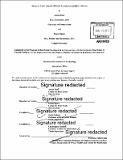Property value impacts of rapid transit accessibility in Boston
Author(s)
Paul, Austin (Austin John); Spurr, Stacey
DownloadFull printable version (16.36Mb)
Other Contributors
Massachusetts Institute of Technology. Center for Real Estate. Program in Real Estate Development.
Advisor
David Geltner and Chris Gordon.
Terms of use
Metadata
Show full item recordAbstract
This thesis evaluates the relationship between rapid rail transit accessibility and investment property values through a series of interviews, literature and report reviews, and a quantitative empirical analysis of over 1,000 investment property sales transactions. Theory tells us that within urban environments, proximity to rail transit generates value that accrues to the real estate owner. Initiatives in various municipalities across the world have attempted to tap into the value created by major projects to help finance infrastructure investment, but there has yet to be one method that is universally applied. Major infrastructure improvements are expensive, time consuming, and challenging to deliver. While there are multiple hurdles to overcome in order to create an expansion or new rail project, finding funding sources is amongst the most difficult. A large focus of the thesis is understanding value creation along rail access nodes in pursuit of evaluating alternative financing sources. We take both a qualitative and quantitative approach to understanding the value creation, including the "announcement effect" prior to actual completion of the infrastructure project. These issues are explored through an examination of the practices in the Boston Metropolitan Region. Specifically, we use a current, in-progress rail expansion, the Green Line Extension (GLX), to investigate the process of delivering a substantial infrastructure project and its impact on real estate value. Such projects have far reaching impacts and effects, so throughout the thesis we broaden the lens and highlight issues, ancillary benefits, and experiences of other cities that have endeavored to undertake similar projects. Among our major quantitative findings, we observe that, within the Northwest Boston Basin (our focus area), having close proximity to operational rail rapid transit stations adds up to $48/SF, or nearly 39%, to property value, holding all else constant as best as data allows (including land use). We find some evidence that the GLX project may ultimately increase property values even more than this, as our study indicates that properties near planned GLX stations appear to have already increased substantially in value relative to otherwise similar properties subsequent to the announcement of specific planned station locations in 2008.
Description
Thesis: S.M. in Real Estate Development, Massachusetts Institute of Technology, Program in Real Estate Development in conjunction with the Center for Real Estate, 2016. Cataloged from PDF version of thesis. Includes bibliographical references (pages 131-135).
Date issued
2016Department
Massachusetts Institute of Technology. Center for Real Estate. Program in Real Estate Development.; Massachusetts Institute of Technology. Center for Real EstatePublisher
Massachusetts Institute of Technology
Keywords
Center for Real Estate. Program in Real Estate Development.